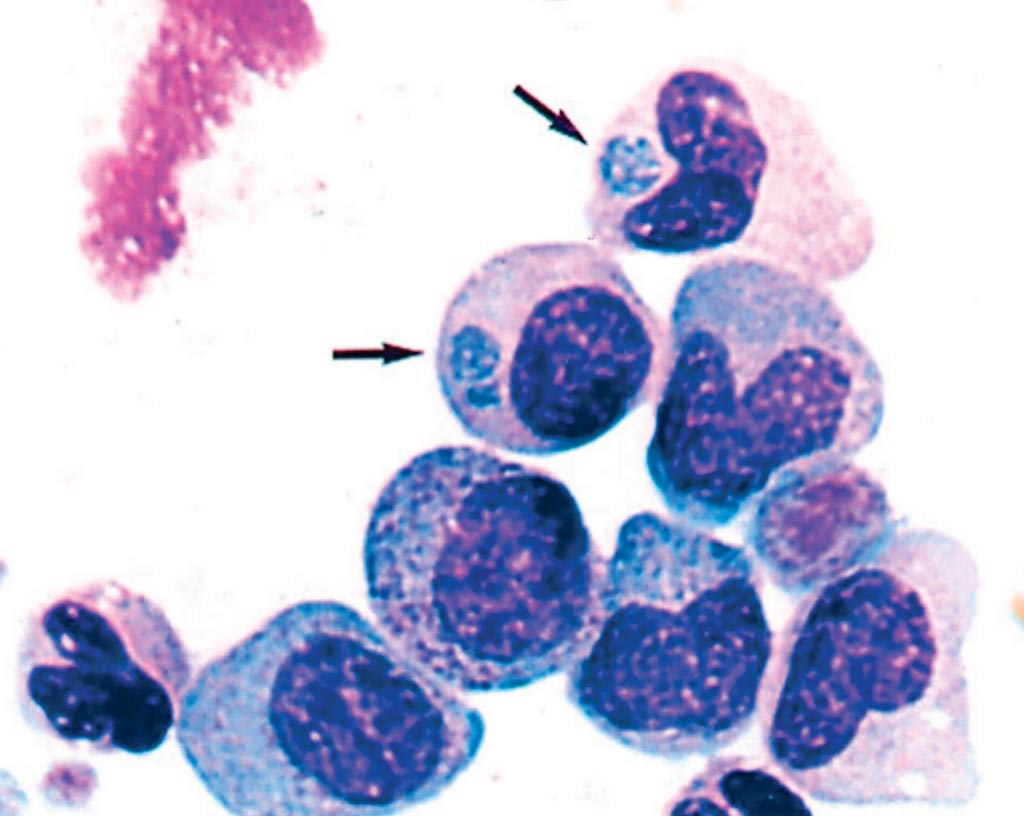Tick-Borne Diseases Diagnosed with Multiplex Molecular Panel
By LabMedica International staff writers
Posted on 26 Dec 2018
Tick-borne diseases, which afflict humans and other animals, are caused by infectious agents transmitted by tick bites. Tick-borne illnesses are caused by infection with a variety of pathogens, including rickettsia and other types of bacteria, viruses, and protozoa.Posted on 26 Dec 2018
Although Lyme disease is the most prevalent tick-borne infection in the USA, experts are seeing more serious tick-borne illnesses, some of them fatal if not treated right away. It’s difficult to predict from year to year how many cases of tick-borne diseases will be reported in the USA. The tiny arachnids are now in 50 states, and as a result, more people are at risk every spring, summer, and fall.

Image: Photomicrograph of a buffy coat smear of the patient’s blood collected on the third hospital day. Anaplasma phagocytophilum inclusions are seen in the cytoplasm of two different granulocyte stages (a metamyelocyte and a myelocyte). Arrows indicate morulae (Photo courtesy of Westchester Medical Center).
ChromaCode Inc (Carlsbad, CA, USA) has launched a nine-target, quantitative polymerase chain reaction (qPCR) panel test that can detect a total of 12 species that are typically transmitted to humans by ticks in various regions of the USA. The core technology, called high-definition PCR (HDPCR), enables standard thermal cyclers to run multiplexed panel tests. Essentially, it modifies standard TaqMan chemistry to create unique curve signatures depending on the targets present, with specialized, user-friendly, cloud-based software to deconvolve and interpret the curves.
The test detects a total of nine DNA targets from bacteria and protozoa carried by ticks that bite people, but two of those targets can pick up multiple species. The bacterial targets include Anaplasma phagocytophilum, which is the cause of anaplasmosis, three species of Ehrlichia: Ehrlichia chaffeensis, Ehrlichia ewingii, Ehrilicha muris eauclarensis and Rickettsia species that are known to cause Rocky Mountain Spotted Fever. The test also detects a few of the most common Borrelia species, a type of spirochete bacteria that is the cause of Lyme disease. Specifically, it detects Borrelia miyamotoi, as well as a target the firm calls Borrelia Group #1, which includes B. burgdorferi and the newly-discovered B. mayonii, and a target called Borrelia Group #2 that detects B. hermsii, B. parkeri, and B. turicatae. The test also detects DNA of one tick-borne protozoa, Babesia microti that is the cause of Babesiosis, an infection most common in the Northeast.
Blake Buchan, PhD, a pathologist at the Medical College of Wisconsin (Milwaukee, WI, USA) evaluated panel to test 175 prospectively collected samples from patients suspected of having Lyme disease, as well as 20 retrospective samples from known positive cases, 93 simulated specimens, and samples collected locally as well as ones from a more rural part of Northern Wisconsin. Overall, the evaluation found 19 clinical samples tested positive, and all had one of three targets, namely the A. phagocytophilum, B. microti, or B. miyamotoi. Compared to singleplex PCR testing, the latter two targets showed 100% sensitivity and specificity, while the former had 100% specificity and 91% sensitivity. There were two false-positive results, one for E. muris eauclarensis and one for the Rickettsia species target, which were retrospective clinical samples positive for A. phagocytophilum. The panel also uncovered two cases in which the pathogens that were detected were things the clinicians would not otherwise have tested for. The results were presented at the Association for Molecular Pathology meeting held November 1-3, 2018, San Antonio, TX, USA.
Related Links:
ChromaCode
Medical College of Wisconsin













